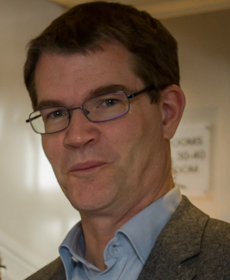A word from the EP Deputy Department Head - March 2022

Dear Colleagues in EP,
Welcome to the first edition of the EP newsletter in 2022. Let me take a few words to introduce myself – my name is Richard Hawkings, and I started as one of the two deputy department heads in January, taking over from Roger Forty who has served in this role for many years. I have been a research physicist at CERN since the year 2000, and have worked in the OPAL experiment at LEP and ATLAS experiment at LHC, with interests in precision electroweak, top quark and flavour physics. More recently, I have worked on the measurement of the luminosity in ATLAS, which has brought me into contact with LHC operations and colleagues from the accelerator sector, and overseen the physics analysis activities of the CERN ATLAS team. Over the last decade, I have also been involved in the recruitment of research fellows and staff, and in the summer student programme. I look forward to working with you all in my new role in the EP department management.
As I write, the laboratory is starting to feel busier, awakening from its winter hibernation as COVID restrictions are being lifted, in-person meetings are once again possible, and more of the user community is returning. With the restart of the smaller accelerators and experiments after the winter stop, soon to be joined by the LHC after its long LS2 shutdown, we can look forward to a productive year of data-taking, profiting from all the maintenance and upgrades performed over the last few years, and eventually a harvest of new physics results. At the same time, we are all very conscious of the ongoing Russian invasion of Ukraine, the unfolding humanitarian disaster, and the consequences for many of our colleagues and collaborators. CERN is founded on the idea of peaceful scientific collaboration, and we wait anxiously to understand the full implications of this developing crisis.
Turning now to this issue of the newsletter, you can read about the strenuous efforts to complete the phase-1 upgrades of the LHC detectors before Run-3 starts, with articles about the ATLAS New Small Wheels and LHCb VELO upgrade. Elsewhere, the ISOLDE nuclear physics facility already had a chance to run with upgraded detectors last year, and you can learn about the commissioning and first results from the ISOLDE Solenoidal Spectrometer (ISS).
Articles from the CMS and ALICE groups look further ahead to the HL-LHC era. They describe design and prototyping work being carried out for two new calorimeters., the CMS HGCAL and ALICE FoCal, which both aim to measure electromagnetic and hadronic showers with unprecedented detail and precision. Such advanced detectors rely on ground-breaking R&D programmes, such as those carried out in the EP-DT and EP-ESE groups. In this issue, you can read about the development of new PICOSEC Micromegas gaseous detectors with a time resolution of ~25 picoseconds, and a new 64-channel time-to-digital converter with a few picosecond resolution, as well as an insight into the efforts being made to reduce the effects of the global semiconductor shortage on detector upgrade programmes.
Elsewhere in this issue, you can find an overview of results from the large ProtoDUNE prototype LArTPC-based neutrino detectors, which are preparing the way for the DUNE underground neutrino experiment in the United States. Looking even further ahead, an article on the 5th FCC physics workshop details the latest discussions on the Future Circular Collider project, its physics goals and detector requirements, as well as reporting on an intriguing panel discussion on the interfaces between science, philosophy and faith. Future particle experiments will also require great strides in software and computing, as an article on data handling and processing for the FCC attests.
This newsletter also showcases a number of recent physics results from the CERN experiments. Here you can read about the search for magnetic monopoles (a hypothetical particle with a non-zero magnetic charge) at the MoEDAL experiment installed in the LHCb cavern. An article from LHCb reports on recent precise measurements of CP-violation in the decays of beauty and charm hadrons, which help shed light on the possible origins of the matter-antimatter asymmetry in the universe. The BASE experiment at the Antiproton Decelerator (AD) facility has made an exquisite comparison of the properties of protons and antiprotons, demonstrating that the magnitude of their charge-to-mass ratios are equal to a precision of 16 parts per trillion. Finally, an article from two theorist colleagues shows how recent measurements of the scattering between two vector bosons (W or Z particles) can be reinterpreted to provide information on potential axion-like particles (ALPs), another family of hypothetical particles that could have relevance for several open questions in particle physics. Happy reading!
